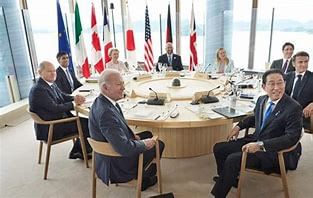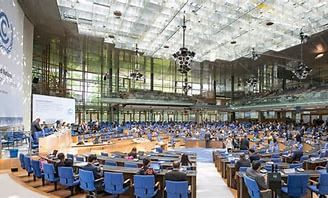UPSC Daily Current Affairs- 16th June 2024 | Current Affairs & Hindu Analysis: Daily, Weekly & Monthly PDF Download
GS3/Environment
The Environmental Flows (E-flows) Monitoring System
Source: The Hindu

Why in News?
The Union Jal Shakti Ministry introduced an e-flow ecological monitoring system to enable real-time planning and monitoring of projects, river water quality, and other critical parameters.
What is the Background in which the E-flows Monitoring System Launched?
- The Government of India mandated minimum E-flow for various stretches of the Ganga River to be maintained year-round in 2018.
- The National Mission for Clean Ganga (NMCG), under the Jal Shakti Ministry, established flow specifications to preserve the river's ecological balance, protect aquatic life, and ensure sustainability amid diverse water usage demands.
What is the E-flows Monitoring System?
- The system, developed by the NMCG, facilitates real-time analysis of water quality in the Ganga, Yamuna, and their tributaries.
- It enables monitoring of activities related to the Namami Gange programme at the central level, including the performance of Sewage Treatment Plants (STPs) and ensuring their operation at full capacity.
What is the Significance of the E-flows Monitoring System?
- The E-flows Monitoring System is a crucial step towards ensuring the continuous and sustainable flow of the Ganga River.
- It tracks key parameters such as in-flow, out-flow, and mandated E-flow across 11 projects along the Ganga Mainstream.
About Namami Gange Programme
- The Namami Gange Programme is an integrated conservation mission sanctioned as a 'Flagship Programme' by the Union Government in 2014 with a budget outlay of Rs. 20,000 Crores.
- Administered by the Ministry of Jal Shakti's Department of Water Resources, River Development and Ganga Rejuvenation, the program aims at effectively reducing pollution and conserving and rejuvenating the National River Ganga.
GS2/International Relations
G7 Summit commits to promoting IMEC
Source: Outlook

Why in news?
The Group of Seven (G7) industrialized nations have pledged to support concrete infrastructure initiatives, including the India-Middle East-Europe Economic Corridor (IMEC).
- This commitment was made in the G7 Summit Communique, released at the end of the three-day G7 Summit, which was attended by PM Modi (India was a special invitee along with Brazil, Argentina, UAE and Turkiye, among others.).
About
- The Middle Corridor, officially known as the Trans-Caspian International Transport Route (TITR), is a key logistics and transportation route that connects Europe and Asia.
- It provides an alternative to the traditional Northern and Southern corridors, enhancing trade and economic cooperation between the regions it traverses.
- The Middle Corridor begins in Southeast Asia and China, crosses Central Asia through countries such as Kazakhstan, Azerbaijan, and Georgia, and reaches Europe via Turkey.
- The corridor involves multimodal transportation, including rail, road, and maritime routes across the Caspian Sea.
Background
- At the sidelines of the G20 Summit held in New Delhi in September 2023, an MoU was signed to develop a rail and shipping corridor connecting India to Europe.
- This corridor would pass via the Middle East between India, United States, Saudi Arabia, the United Arab Emirates, France, Germany, Italy, and the EU.
- It has been known as the India-Middle East-Europe Economic Corridor (IMEC).
- The IMEC is a major infrastructure initiative aimed at enhancing connectivity and economic integration between India, the Middle East, and Europe.
Significance
- Economic Growth
- Enhanced connectivity will reduce transportation costs and time, making trade more efficient and competitive.
- Strategic Connectivity
- Energy Security
- Technological and Infrastructure Development
- Geopolitical Influence
Challenges
- Political Instability
- Funding and Investment
- Regulatory and Legal Issues
- Security Concerns
Four priority pillars of PGII
- Climate and energy security
- Digital connectivity
- Gender equality and equity
- Health and health security
Support extended to IMEC
- At the end of the three-day G7 Summit held in Apulia, Italy, the Group of Seven nations committed to promote the IMEC.
Support to other infrastructure project
- G7 also extended support for the Lobito Corridor in Central Africa and Luzon Corridor and the Middle Corridor.
- It extends from the port city of Lobito on the Atlantic coast of Angola through the Democratic Republic of the Congo (DRC) and into Zambia.
- It is a strategic economic and infrastructure corridor located on the island of Luzon in the Philippines. Luzon is the largest and most populous island in the Philippines.
GS2/Polity
Should the Recent Stock Market Volatility be Probed?
Source: The Hindu

Why in News?
The Indian stock market witnessed significant fluctuations following the release of exit poll results earlier this month and again on June 4 when the Lok Sabha election results were announced. Despite this, the Nifty and the Sensex have managed to recover their losses.
Background
- The Nifty and the Sensex surged on June 3 after the exit poll results predicted a strong win for the BJP, reaching all-time highs.
- Companies with perceived government affiliations, like the Adani Group, and public sector companies expected to benefit from PM Modi's anticipated third term, saw significant gains.
- However, on June 4, both indices plummeted by nearly 6% as the actual election results deviated from the exit poll forecasts.
- This decline marked the sharpest single-day drop since March 2020, wiping out around ₹30 lakh crore of investor wealth.
- Before the exit poll results, the Prime Minister and the Home Minister encouraged investors to purchase stocks before June 4 to capitalize on the expected election outcomes.
Opposition's Allegations & SEBI's Norms
- The opposition accused PM Modi and HM Shah of prompting retail investors to buy stocks before the election results to manipulate the market in favor of specific foreign investors.
- They pointed out a significant increase in the value of stocks traded for cash on May 31, the day before the exit poll results were disclosed.
- Over half of the purchases on May 31 were made by foreign investors, who had been predominantly selling stocks until that day.
- Analysts suggested that the PM's statements before June 4 benefited these foreign investors, resulting in a 3% market upswing before the exit poll results were announced.
- The opposition demanded a joint parliamentary committee (JPC) investigation into the issue.
SEBI's Norms on This Issue
- SEBI states that spreading false or misleading information to influence securities trading is illegal.
- General comments on market trends through mass media are permissible, distinct from leaking confidential information to specific investors for personal gain.
- Unless collaboration between PM Modi and select investors to boost the market pre-exit poll results is proven, his public statements encouraging pre-election buying are likely not unlawful.
Central Government's Response
- Union Minister Piyush Goyal countered the opposition's claims by indicating that foreign investors bought high and sold low, while Indian investors leveraged market fluctuations to sell high and buy low.
- Data from NSE demonstrates that retail investors were net sellers on May 31 and June 3 when the market surged, and net buyers on June 4 when the market crashed.
GS2/Polity
Centre considers extension of Smart Cities Mission
Source: Indian Express

Why in news?
With only 15 days left until the June 30 deadline, the Union Housing and Urban Affairs Ministry is thinking about extending the Smart Cities Mission. This extension would give cities more time to finish ongoing projects, which make up about 10% of all the projects.
About
- It was launched on 25 June, 2015, with the objective to promote cities that provide core infrastructure, clean and sustainable environment.
- 100 cities have been selected to be developed as Smart Cities (through a two-stage competition) in various rounds from 2016 to 2018, with each getting five years from their selection to complete the projects. i.e., the original deadlines were from 2021 to 2023.
- After the COVID-19 pandemic broke out, the deadline for all 100 cities was fixed to June 2023 in 2021.
- In May last year, the Ministry again extended the deadline, this time to June 30, 2024.
- It is a Centrally Sponsored Scheme under the Union Ministry of Housing and Urban Affairs (MoHUA).
Principles
The six fundamental principles on which the concept of Smart Cities is based are:
- It will ensure a decent quality of life to their citizens through the application of 'smart solutions'.
- It aims to drive economic growth and improve quality of life through comprehensive work on social, economic, physical, and institutional pillars of the city.
- The focus is on sustainable and inclusive development by creation of replicable models which act as lighthouses to other aspiring cities.
- The Smart Cities Mission in India is a Centrally Sponsored Scheme. It requires state governments and urban local bodies (ULBs) to contribute an equal amount for implementing projects under the Smart City Proposal (SCP).
Performance of SCM
- Out of the completed projects, 5,588 projects worth Rs 65,996 crore were funded under the Mission.
- The remaining are from the cities' own resources, PPP mode, convergence with other missions, and other sources.
- All 100 cities have set up Integrated Command and Control Centres at a cost of Rs 11,775 crore.
- The different categories which account for the top categories of completed works include:
- Water, sanitation, and hygiene (WASH) projects worth Rs 44,300.
- Smart mobility projects worth Rs 33,019 crore.
- Smart governance projects worth Rs 15,474 crore.
Report of Parliamentary Standing Committee on Housing and Urban Affairs
- In February 2024, the Parliamentary Standing Committee on Housing and Urban Affairs has submitted its report on the evaluation of the Smart Cities Mission presented in the Lok Sabha.
- The report said that 400 projects, out of the 7,970, worth Rs 22,814 crore would take beyond December 2024 to complete.
- Among the various reasons cited by the report for the delays were difficulties in resettlement of local population and legal issues such as land procurement.
- Frequent transfers of smart cities' CEOs and delay in projects that require convergence with other government ministries or agencies were also flagged.
- It further said that in case of non-completion of these projects within the extended time frame, the state governments concerned will have to complete the projects at their own cost.
GS-III/Defence and Security
JIMEX Exercise-24
Source: The Print

Why in News?
Recently, JIMEX exercise–24 commenced at Yokosuka in Japan.
About:
- JIMEX-2024 marks the eighth edition of this exercise since it began in 2012.
- The exercise consists of both harbour and sea phases.
- The harbour phase includes professional, sports, and social interactions.
- The navies of India and Japan will enhance their war fighting skills and interoperability at sea.
- The Indian Navy's indigenous Stealth Frigate, INS Shivalik, is participating.
- Japan is represented by the Guided Missile Destroyer, JS Yugiri.
- The exercise allows both navies to learn from each other's best practices and facilitates operational interactions.
- It reaffirms the shared commitment of India and Japan towards maritime security in the Indo-Pacific region.
- Other exercises between India and Japan include:
- Malabar: a naval war gaming exercise involving India, Japan, the United States, and Australia.
- SHINYUU Maitri: an Air Force exercise.
- Dharma Guardian: a military exercise.
GS-III/Science and Technology
Liquid Improvised Explosive Device
Source: The Tribune

Why in News?
Liquid explosives have resurfaced in Jammu and Kashmir after 17 years, as a recent police raid uncovered "difficult-to-detect (d2d)" Improvised Explosive Devices (IEDs).
- Forensic analysis suggests the explosives could be trinitrotoluene (TNT) or nitroglycerine, typically found in dynamites.
About Improvised Explosive Device (IED):
- An IED is an unconventional explosive weapon that can take various forms and be activated in multiple ways.
- Used by criminals, vandals, terrorists, suicide bombers, and insurgents.
- IEDs can range from small pipe bombs to sophisticated devices capable of causing extensive damage and loss of life.
- Damage from an IED depends on its size, construction, placement, and type of explosive or propellant used.
- The term IED became widely used during the Iraq War that began in 2003.
- Components of an IED:
- Initiating mechanism: a detonator.
- Explosive charge.
- Casing or projectiles (e.g., ball bearings or nails) that produce lethal fragments upon detonation.
- Materials used in IEDs:
- Various objects and materials including artillery or mortar rounds, aerial bombs, certain fertilizers, TNT, and other explosives.
- Can also include radiological, chemical, or biological components to enhance lethal and psychological effects.
GS-III/Environment and Ecology
No outcome in Bonn
Source: The Indian Express

Why in News?
The recent climate meeting in Bonn, Germany, failed to make significant progress on defining a new climate finance goal. By the end of 2024, countries are required to finalize a new monetary target, exceeding the current $100 billion per year, that developed nations must mobilize to support developing countries in combating climate change.
New Collective Quantified Goal (NCQG)
About
- NCQG is a forthcoming international climate finance target.
- Designed to replace and build upon the current $100 billion annual commitment by developed countries to support climate action in developing countries.
- Aims to establish a more ambitious financial target reflecting the evolving needs and challenges of climate change, particularly in developing nations.
Key Aspects
- Increased Financial Commitment: Expected to exceed the current $100 billion annual target, acknowledging the growing financial needs for climate mitigation, adaptation, and resilience.
- Expanded Scope: Will address not just the amount of financial resources but also sources of funding, types of projects, and effective disbursement and utilization mechanisms.
- Inclusivity and Fairness: Ensures equitable contributions based on capabilities and responsibilities.
- Monitoring and Accountability: Establishes systems to track the flow and impact of climate finance, ensuring transparency and effectiveness.
Finalization
- Expected to be finalized and adopted at upcoming climate conferences, such as COP29.
Centrality of Money in Climate Action
Need of Developing and Poor Countries
- Money is essential for climate action: Required for mitigation, adaptation, and tasks like collecting and reporting climate data as per the 2015 Paris Agreement.
- Developing and poor countries face significant funding challenges due to capacity gaps.
Obligation under UN Framework Convention on Climate Change (UNFCCC)
- Rich and developed countries are obligated to provide financial support to developing nations to combat climate change, being primarily responsible for its causes.
- 2009 pledge: Developed countries committed to mobilizing $100 billion annually from 2020.
2015 Paris Agreement
- Mandates periodic increases in climate finance contributions by developed countries after 2025.
- NCQG is intended for the post-2025 period and is set to be finalized this year.
Report of Organisation for Economic Cooperation and Development (OECD)
- OECD reported achieving the $100 billion target in 2022, but developing countries dispute this claim, citing double-counting and creative accounting by developed nations.
How Much Money is Required?
For Implementing Climate Commitments
- Developing countries need trillions of dollars annually, not just billions.
- UNFCCC assessment: About $6 trillion required by 2030.
For Adaptation
- Annual needs: Between $215 billion and $387 billion.
- Global transition to clean energy: $4.3 trillion annually until 2030, and about $5 trillion annually until 2050 for net-zero emissions.
Demand by Various Countries
- India proposed at least $1 trillion annually after 2025.
- Arab countries suggested a minimum of $1.1 trillion.
- African countries demanded $1.3 trillion.
- Developed countries have not made public offers, only acknowledging that the new target must exceed $100 billion per year.
Debate Over Contribution
Annexure 2 Countries of the UNFCCC
- Only 25 countries listed in Annexure 2 are obligated to provide climate finance.
Responsibilities Being Shifted to Other Countries
- Annexure 2 countries argue that many countries are now economically stronger than in the early 1990s when the list was created.
- Financial requirements for climate action are too large for the original group alone to meet.
- Countries like China, oil-rich Gulf states, and South Korea are not part of Annexure 2.
Outcome of Bonn Summit
- Bonn talks did not produce specific indicative numbers for climate finance.
- Resulted in a 35-page, 428-paragraph input paper outlining wish lists of various countries.
- Contributors: Identifying countries for the climate finance pool.
- Allocation: Determining fund usage, including specific projects and initiatives.
- Monitoring: Establishing mechanisms for tracking and managing the flow of finance.
- Input paper to evolve into a formal negotiating draft for discussions at COP29.
GS-II/International Relations
Kavli Prize
Source: Indian Express

Why in News?
The winners of the 2024 Kavli Prize were announced on Wednesday. Eight winners were awarded for their contributions to astrophysics, neuroscience and nanoscience.
About:
- It is awarded in honour of Norwegian-American businessman and philanthropist Fred Kavli (1927-2013)
- The Kavli Prizes are awarded in three areas: astrophysics, nanoscience and neuroscience — the largest, the smallest, and the most complex. The inaugural prize was announced in 2008.
Winners in 2024:
- ASTROPHYSICS: This year’s prize for astrophysics has been awarded to David Charbonneau, and Sara Seager for discoveries of exoplanets, and the characterisation of their atmosphere.
- NANOSCIENCE: Robert Langer, Armand Paul Alivisatos, and Chad Mirkin were given the prize for nanoscience for biomedical applications breakthroughs.
- NEUROSCIENCE: The prize in neuroscience has been awarded to Nancy Kanwisher, Winrich Freiwald, and Doris Tsao for their collective effort over decades to map the linkage between facial recognition and the brain.
|
38 videos|5293 docs|1118 tests
|
FAQs on UPSC Daily Current Affairs- 16th June 2024 - Current Affairs & Hindu Analysis: Daily, Weekly & Monthly
| 1. What is the purpose of the Environmental Flows (E-flows) Monitoring System? |  |
| 2. What does the G7 Summit commit to promoting regarding IMEC? |  |
| 3. Should the Recent Stock Market Volatility be probed and why? |  |
| 4. What is the Smart Cities Mission and why is the Centre considering its extension? |  |
| 5. What is the JIMEX Exercise-24 and why is it important? |  |
















